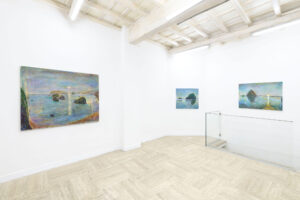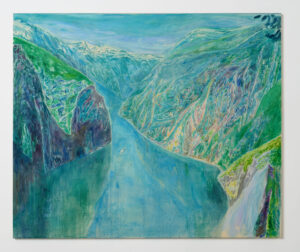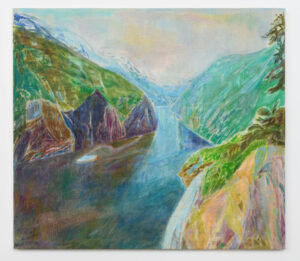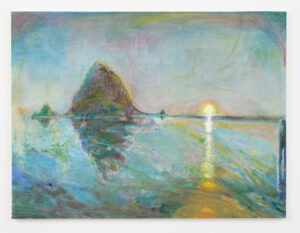To better understand the dynamics of current art criticism, it would be appropriate to formulate a new way of interpreting exhibitions, assessing how much novelty they manage to convey despite their unsuspected classicism. Always according to this innovative approach, one could broaden the introspective implications of individual projects, revealing thoughts and constructive uncertainties effectively. It is in line with the indicated reading method is the exhibition dedicated to Colin Brant (Arcata, California, 1965) titled “Tibbar Tibbar”, scheduled at the Richter Fine Art Gallery in Rome until January 12, 2024, which, as mentioned above, encourages us to think differently, namely like mountains. Imagining oneself in this way presupposes a «bizarre, variably geometric state of mind, due to crystalline surfaces and sinuous lines».[1]

Colin Brant, “Tibbar Tibbar”, Galleria Rihcter Fine Art, Roma, courtesy Galleria Richter Fine Art, Roma, ph. credit Giorgio Benni
Even though this invitation might seem that of a madman, it hides a unique ability of the artist: to study the world through a curious and visionary nature. And here the elegant landscape views are revealed, characterized by a singularly mischievous, narrow and winding nature. Despite the repetition of the exhibited pieces, to which the eye easily tends to get accustomed, there is a visual frenzy that legitimizes the audacity of an artist who launches a solid provocation, in which everything is real but also fabricated; because the iconographic sources from which the painter draws inspiration are stereoscopic images from the 19th century that lead him to work on a particular theme: the similarity to the real and its livelier evasion.

Colin Brant, “Tibbar Tibbar”, Galleria Rihcter Fine Art, Roma, courtesy Galleria Richter Fine Art, Roma, ph. credit Giorgio Benni
In this way, the exhibition turns out to be paradoxically splendid because Brant is an exquisitely disorienting painter who deals with the landscape not in its postcard-like pathos, but rather enhances its visual freshness and unique glimpses. Furthermore, his technique presupposes an extravagant decomposition and breakdown of color, where bright patches collect shades from cold turquoise to pulpy apricot, as in an elaborate madness that allows glimpsing the joints distributed in a patient play of linear forms. And since the gradations deeply attract through the powerful and suggestive exercise of the working technique, the infinite lattice at the crystal tip full of colorations becomes revealing. It is a process of visual sensitization in which painting emerges as in the magnetic fields of physics, where the force lines arrange around central points such as sea rocks, rocky clefts and even bright solar spheres, interacting reciprocally.

Colin Brant, “Fjord 2”, oil on canvas, 127 x 152 cm, 2022, courtesy Galleria Richter Fine Art, Roma, ph. credit Giorgio Benni
One wonders if the relationship with figuration conceals, like an enchanting miscellany of a fascinating succession, the intention to make visible the transparencies of the landscape atmosphere that now appears frayed, dissolved, barely hinted at, with light touches on the raw surface of the canvas. However, what attracts is how paradoxically the landscapes are fixed with a figurative construction based on the charm of the material, seducing with fluid and delicately spurious colorations but forming with grace, an impure artifice that genuinely defines the complexity of the place.

Colin Brant, “Sognefjord”, oil on canvas, 76 x 86 cm, 2023, courtesy Galleria Richter Fine Art, Roma, ph. Credit Giorgio Benni
However, Brant portraying fjords and glimpses of Rocky Mountains, does not perform a mere phenomenological reduction; rather, the chosen subject remains functional to his painting as erratic notes of a fictitious traveler. In other words, they are itinerant tales as large as the canvases on which he fixes manageable landscapes and portable skies. Thus, the pictorial surface is also a mental condition as well as a spatial one, a place continuously urged to coagulate a concrete image that, like an oxymoron, transforms Brant into a contemporary painter in his radical non-contemporaneity. Nevertheless, the views are characterized by a no less clear than hallucinatory character; they are an explosion of fracturing lights that fix the subject in splinters of liquid forms. However, such bright luminosity does not dazzle or aspire to clarify features; rather, it aims to narrate the phenomenal richness of existence. In the fjords, it will be natural to perceive the rude and acrid frost of a land that constantly originates polar cold.

Colin Brant, “Fjord 1”, oil on canvas, 127 x 152 cm, 2022, courtesy Galleria Richter Fine Art, Roma, ph. Credit Giorgio Benni
In this way, those distant and almost lost places live by their own rules: the mountains combine with the clouds, and the water becomes ether, and both realities exist as mere containers of physical matter. They are the intoxicant of air, caressing with a happy violence, giving life and space to scents of sub-marine transparencies between light and shadow enveloped in humid spaces. Nevertheless, Brant reveals other elements typical of a shamelessly real landscape, namely the archaic silence, the pungent and sharp acrimony of the bitter breeze, harsh and clean characteristic of a moderately wild place. This undeniable ability to convey the sense of atmosphere and distance derives from the artist’s intellectual grasp, always attentive to safeguarding the sense of form, capturing with lines, colors and directions of energy the sensation of flight and elevation. Thus, nature is not just a means but the goal to achieve its interpretation.

Colin Brant, “Sunset Rock”, oil on canvas, 76 x 100 cm, 2021, Courtesy Galleria Richter Fine Art, Roma, Ph. Credit Giorgio Benni
The ability to render in painting abstract qualities typical of such a unique environment, such as solidity and coldness, is possible for Brant thanks to the different management of lines. Thus, if any movement draws a form and the human being, like «the entire nature has the appearance of a crystal»[2], the artist’s traces are not intended to be just simplifying, but adhere to a sought-after complexity. This geometry, like a massive crystal, does not allow understanding its forms except mutually, so each facet emerges individually in the chromatic filaments before being read as a whole. Therefore, this elegant pictorial weave that tears the canvas into pure and mixed tones prompts us to wonder what someone who thinks of the world as a collector of crystalline geometric forms, or as a mountain, might feel. It goes without saying that knowing oneself in this way is equivalent to recognizing the world as a system of unequal geometry, as a generator of eternal, pure, concrete and non-existent crystallized images.
Maria Vittoria Pinotti
[1] Giorgio Manganelli, La notte, curated by Salvatore Silvano Nigro, Adelphi Edizioni, Milano, 2016, p. 87
[2] Edvard Munch, Frammenti sull’arte, curated by Marco Alessandrini, Abscondita, Milano, 2019, p. 43
Info:
Colin Brant, Tibbar Tibbar
Galleria Richter Fine Art, Vicolo del Curato 3, 00186, Roma
2/12/2023 – 12/1/2024
Opening Hours: Monday to Saturday from 3 pm to 7 pm, or by appointment
www.galleriarichter.com

Maria Vittoria Pinotti (1986, San Benedetto del Tronto) is an art historian, author, and independent critic. She currently is the coordinator of Claudio Abate’s photographic archive and Manager at Elena Bellantoni’s Studio. From 2016 to 2023 she was the Gallery Manager in a gallery in the historic center of Rome. She has worked with ministerial offices such as the General Secretariat of the Ministry of Culture and the Central State Archive. Currently, she collaborates with cultural sector magazines, focusing on in-depth thematic studies dedicated to modern and contemporary art.






NO COMMENT